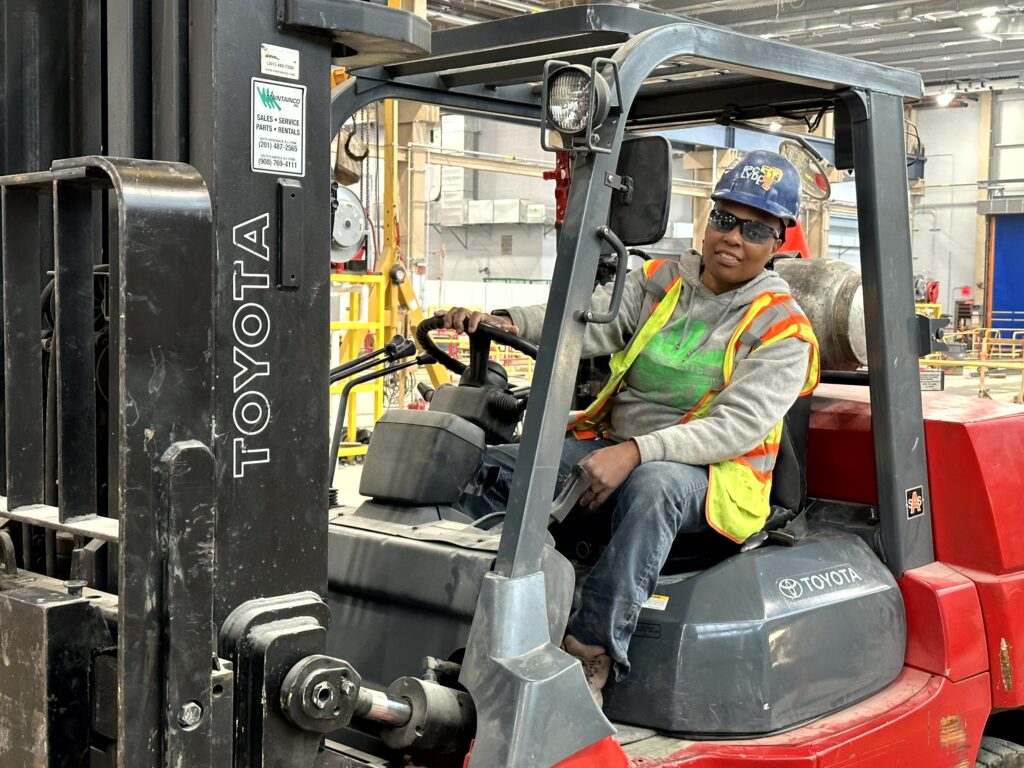By: Sharice Elmore, Union Millwright of Local 740
What if I told you, you could make a good income, receive quality healthcare benefits, retire with a pension, and have a meaningful, exciting career, all without getting a college degree or going into debt for your education? In New York’s unionized construction industry, it’s possible.
I am a union carpenter, working as a millwright with Local 740. I joined a pre-apprenticeship program for women that brought me into the unionized trades back in 2005, and I’ve been doing what I love ever since. Thanks to union carpenters and contractors, I’ve had steady work for the past 18 years, I receive great wages and benefits, and I’ve been supported by my brothers and sisters in the union the whole way. Today, I’m a homeowner and I’m looking forward to a comfortable retirement in the future.
New York City can be a tough place to make it . I’ve seen friends leave the city when their rents hiked up. With the skyrocketing cost of living, New York’s working class is in a tough spot. But, at a time when it seems increasingly impossible to make a wage that affords a comfortable life in New York City, I am here to tell all the young New Yorkers out there that there is a way: union work.
I feel incredibly grateful for my career with union carpenters and contractors and the life it’s afforded me. In addition to the life-changing pay and benefits I’ve received, the training, comradery, and diversity set the union apart as a great place to work.
Union carpenters and contractors operate at the highest levels of quality and training. Union contractors hire us because of the unparalleled work we provide, backed by years of state-of-the-art instruction. Our apprentices go through four years of training to master their craft. Before a union carpentry apprentice ever steps foot on a jobsite, they will complete over 80 hours of training. Then throughout our careers, we are constantly able to utilize the union’s training center and courses to learn new skills and update our certifications. Union carpenters and contractors put skill and safety training as the number one priority to prepare our workers to build New York’s best.
The vast resources of the union also bring opportunities for mentorship and community building. I wouldn’t be where I am today without the mentors and colleagues who have helped me along the way. Despite all the great things I have to say about my career, there have certainly been times I’ve felt discouraged. In my second year, there was a stretch of time when I wasn’t getting much work. I got called in for a one-day job that thankfully, with the support of my union brothers and sisters and the union contractor who was my employer, turned into a six-week one. That gave me the experience I needed to get hired again and again after that. We really take care of each other, and I try every day to pass that comradery on to the next generation of union carpenters and contractors.
One thing I love to see about the next generation is how diverse the union has become. Union carpenters and contractors really invest in diversity so that our members are reflective of the communities where we work. When I walked into my first union meeting almost two decades ago, I was one of three Black people present and the only woman. Now, I work alongside many Black union brothers and sisters, and women are increasingly represented in each apprenticeship class.
Since joining the union, I’ve gone from struggling to get by to owning property, saving for retirement, and moving up the ranks. I’m currently working my first job as a foreperson, meaning I oversee my jobsite and direct the other workers. I love what I do and feel confident handling any challenges along the way.
I feel lucky to be just one example of how union carpenters and contractors uplift working people here in New York City. Joining the union has definitely been the best thing I’ve ever done in my life. I’m speaking out with pride about union carpenters and contractors to make sure New York City continues to be a union town and union work can continue to be a pathway to stable futures for the next generation.


